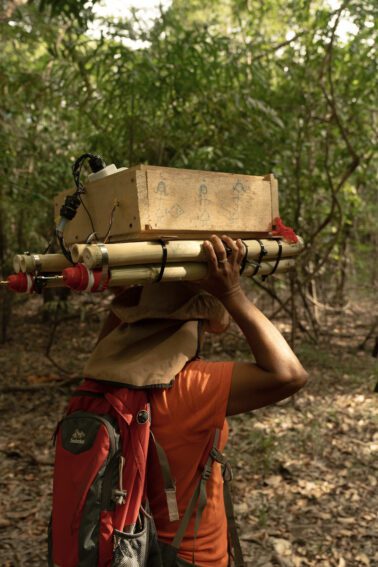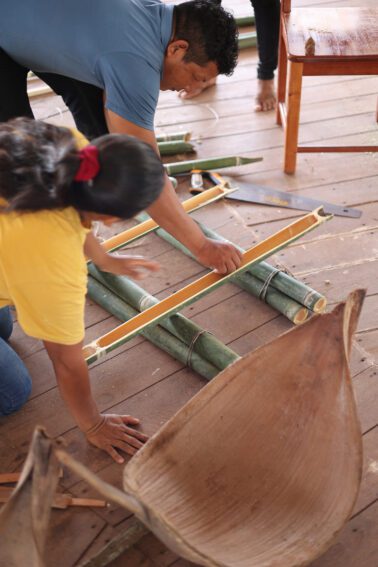While many countries in the Global South have had interventions by outside experts to “help” or “teach” local communities to take care of their resources, indigenous researchers in Guyana are innovating in the way they address environmental and health issues. Own knowledge and skills.
None of them have completed secondary education, but they have become data technologists as they participate in different projects that control the entire data cycle: establishing what needs to be investigated, planning and implementing the appropriate data protocol. Collecting data, analyzing that data, communicating results to a wider audience, and supporting decision making.
„Traditional research is extractive. Many scientists come, stay for a while, take data, use indigenous people as cheap data collectors, and then the data disappears (…) So my perspective is one of long-term commitment; regardless of whether there is funding or not, we maintain the relationship. , so that indigenous scientists have control over the research process.
Andrea Berardi is an Environmental Information Systems Researcher at the Open University, UK
These data technicians belong to the Makushi tribal community that lives in the wetlands and savannas of the north. Rubununi, in southwestern Guyana. The region is considered by the International Union for Conservation of Nature (IUCN) to be one of the world's major tropical forest areas and an ecological „hotspot”, that is, a place with an exceptional concentration of native species facing rapid loss. their natural habitat.
These losses are caused by threats such as mining, logging, road and highway construction, fire and drought, as well as industrial agriculture. A Report 2019 also describes other problems, such as intensive fishing and illegal hunting, which deplete the populations of paiché, tapir, iguana, capybara, caiman and turtles, which are sold by outdoor hunters to feed demand in urban areas, neighboring countries or mining areas. .
For more than two decades, Andrea Berardi, a researcher in environmental information systems at the Open University in the United Kingdom, has worked with indigenous communities in Guyana to identify problems and provide solutions based on indigenous empowerment and local experience.
„Traditional research is extractive. Many scientists come, stay for a while, take data, use indigenous people as cheap data collectors, and then that data disappears (…) So my perspective is one of long-term commitment; regardless of whether there is funding or not, we maintain a relationship. , so that indigenous scientists have control over the research process,” Berardi says.
One example is Rebecca Xavier, an indigenous scientist who was able to identify where certain species were found and use the data to, for example, offer ecotourism tours.
“Having Indigenous women as research leaders is not common. It used to be a male-only job, but that's changing. „We have empowered ourselves as tribal women.”
Carolyn Jacobs, Makushi Data Technician
„This monitoring allowed us to identify different animals, birds and fish, wildlife in general. So now we know what's in our community, we have more control and we feel stronger,” Xavier said. SciDev.Net.



Monitoring allows magushi to assess their territory and the types of flora and fauna that inhabit it. Image credit: Lucio Martus.
These programs have also led to changes in leadership. “Having Indigenous women as research leaders is not common. It used to be a male-only job, but that's changing. We have empowered ourselves as tribal women,” said Caroline Jacobs, Makushi data technician.
Part of this monitoring is done using tools from the same environment, such as pieces of bamboo. “We are making technology accessible to people living in these areas. Let it be very low cost and built on site so that everyone knows how it works. So they learn about electronics, coding and manufacturing,” explains Louisa Charles, a British engineer who is part of the team.
Using these types of instruments, especially aquatic drones, domestic researchers can measure key aspects of water such as pH, temperature and electrical conductivity „which is great for understanding how much salt and other minerals are dissolved in water and assessing its purity.” Charles said. For example, when they measured the water in the drinking well, they found that it was very acidic (pH around 5) and it could have consequences for their health.



The Makushi tribal community learned to make drones using available materials such as bamboo and wood. Image credit: Lucio Martus.
„They measured the water quality of different water bodies where they fished and the places with the highest biodiversity. This gives them a basis for monitoring the impact of large infrastructure development (e.g. road construction), gold mining and climate change,” Berardi explained.
Another challenge facing indigenous communities in Guyana is malaria. According to Global Malaria Report 2022 According to the World Health Organization, it is the fifth country in the region most affected by the disease, after Venezuela, Brazil, Colombia and Nicaragua. In 2021 there were 524,200 cases in the United States, 4 percent of which occurred in Guyana.
“There are constant cases of malaria in my community. People who have passed through the forest or mining areas, then they return home and bring malaria,” said Felix Holden, Makushi, who participated in the program to reduce malaria cases through biological control.
“Till now, whenever there is an outbreak of malaria, the government sends fogging machines with insecticides to all villages. By doing this they not only kill mosquitoes but also pollinators. Malaria is declining, but so are fruit trees and crops,” Berardi said.
So with the DETECT project they used satellite radar data to identify potential breeding areas for malaria-carrying mosquitoes and eliminate them with biological agents.
For bacteria Bacillus thuringiensis It only kills mosquito larvae and can be grown in coconut water or cassava sewage, so there is no need to buy or import expensive insecticides.
„The mitigation is completely under the control of the communities, and that's the goal. They can grow the bacteria, and because they already know how to monitor the concentration of mosquitoes, they use the bacteria in this water and kill the larvae before they turn into malaria-carrying mosquitoes,” Berardi said.
The project initially received 400,000 pounds (US$500,000) from the British government, but support was withdrawn in 2021. However, the group is maintaining the capacity and training of local technicians to seek new sponsorships that will allow them to carry out this strategy on a larger scale.
For Berardi, regardless of funding, it's important to manage the data that communities already have. The researcher believes that the use of technology is applicable to prevent any threat to the biodiversity and health of the population in Guyana so that „communities control their own destiny.”
This article was produced by Latin America and the Caribbean Publishing SciDev.Net

